In case you missed the first part of this series, go read Mark’s first story, Wonder-ful Space-Saving Hacks.
Since October 2020, we’ve made three 7-week trips with our two large, furry Great Pyrenee mixes. We’ve totaled 22,000 miles from our home in Tennessee through 18 states—from the shore of Lake Superior in the north to the Gulf of Mexico, and from the Rio Grande in Texas to the Rockies in Wyoming; on interstates, state highways, winding hilly two-lanes, dirt, and gravel. We’ve stayed in national parks, state parks, city parks, national forest campgrounds, dispersed camping, recreation areas, Harvest Hosts, parking lots, on the side of the highway, in driveways, streets, and of course; even RV parks. Throughout these travels, we have found products that have helped us travel and camp even better.
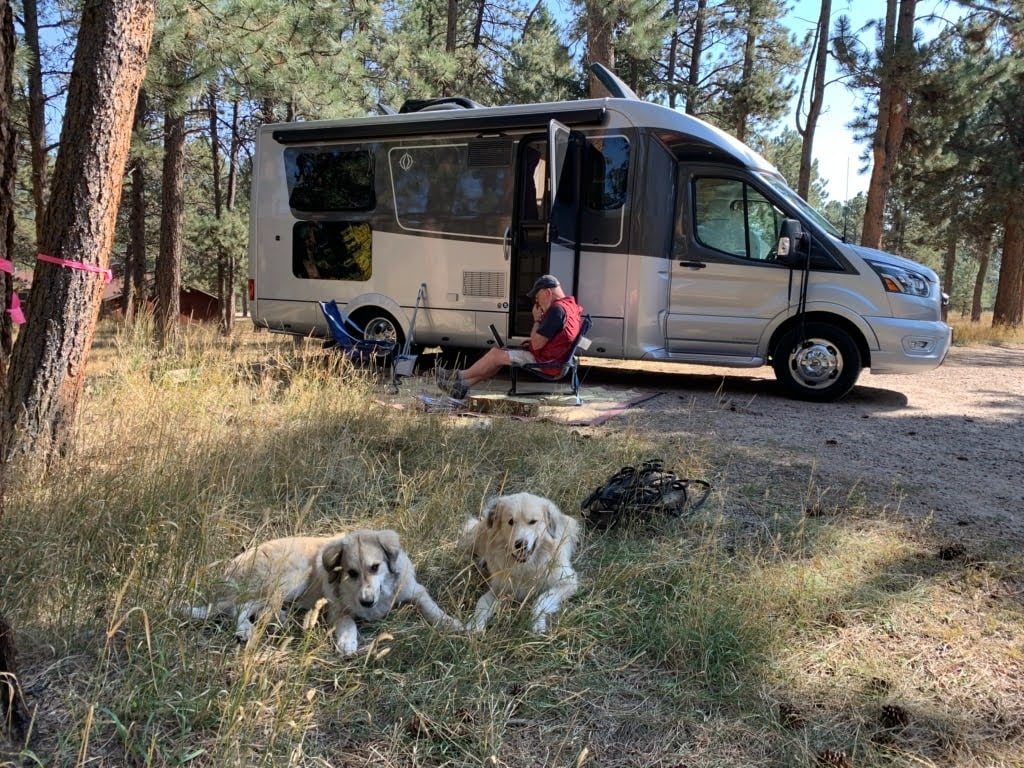
Outside
- We found 18” Nite Ize Gear Ties to be really useful, especially for securing the fresh water hose and 30 amp external power cable. Some people recommend Cable Cuffs. We tried them first, but they were too small for these uses. The Gear Ties’ size, flexibility, and bright color have been an advantage. We now have more for other uses, like long dog leashes and extension cords.
- Clear2O 2-stage water filter system. It’s not as cheap as the single cartridges, but it does a much better job of cleaning up the water you add to your freshwater tanks, and to me, it eliminated the need for another expensive filtration system. The Clear 20 inline filter works in tandem with a first-stage sediment pre-filter—they simply screw together for normal use, and it is compatible with other brands of inline filters if you needed to substitute. When packing up, to avoid leaking in the storage compartment, I empty excess water from the inside of the pre-filter by unscrewing the lid. I detach and shake the water out of the inline filter, then reattach everything before putting it away with the hose in the rear side compartment. The sediment filter can be used for 6 months if you clean it by backwashing—you’ll be amazed at how brown it starts to turn from the gunk it catches. The inline carbon block filter should be replaced every three months of use.
- Inline water pressure regulator. Easy-to-use and reasonably priced We have not found that we needed an adjustable regulator with a gauge, but the ease of use makes it a no-brainer regarding water safety. The order of connection for me is: City water outlet > pressure regulator > Clear20 filter > water hose > Wonder.
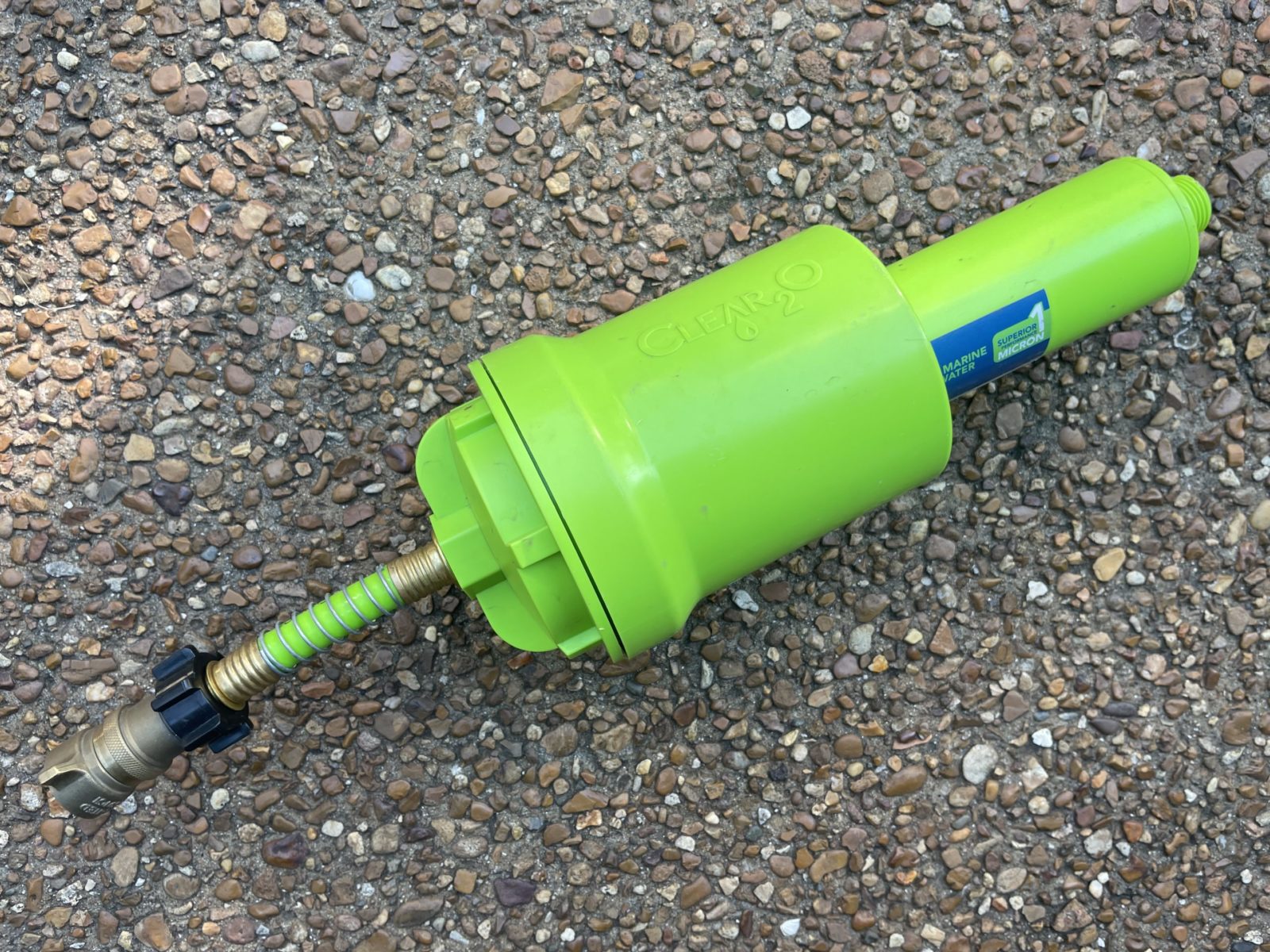
- Some influencers recommend using a quick-release connector for the freshwater hose input connection. We tried them, but they didn’t work for us because of the angle and the limited space where you connect the hose for city water. Perhaps we didn’t get it angled correctly, but our quick connects are now in use in the backyard at home. I don’t mind screwing on the freshwater hose to the Wonder as I can make sure that the inlet to the Wonder’s freshwater tanks is screwed tightly then as well because I’ve noticed it getting loose from time to time.
- Lynx leveling blocks for leveling at the campsite. We got a set of 10. It’s rare that we use more than that, but from time to time, we wish we had an additional four blocks so we could build a pyramid. Instead, we sometimes just stack two blocks and drive up the stack. It works. We keep the blocks in the small side compartment behind the coach entry door. I understand the ease factor of an automatic leveling system, but I’m not sure I can justify the cost difference even if it came factory installed.
- We got a Hughes Power Watchdog 30 external surge protector—the basic model. We know there’s a surge protector built into the Wonder (under the seat behind the driver’s seat), so it’s possible we didn’t need this additional unit. However, you can’t read that one very easily. With the external unit, we can be sure no bad power gets any farther than where this surge protector plugs into the power pedestal, and we can see if there are any issues with the power as soon as we plug the unit in—before we attach our 30-amp cable to the Wonder. There are a couple of great choices on the market, and this one is what we got for the best price at the time; plus, its internal module is replaceable if it triggers. You don’t have to toss the entire unit and start over.
- Everybody has a patio mat, and we’ve gone through three. We forgot and left the first while hurrying through a dump process because we had a line of RVs behind us. Then we got the only one left at the nearest Wal-Mart, and it turned out to be too big, so we returned it. Patio mat number three is a 6′ × 9′, which is the real tip to pass along. It’s large enough for setting up outside the entrance (as was our 8′ × 12′). But this size fits nicely into the long, upper rear compartment where we keep our hoses and cables. It folds flat enough to put on top of them without much difficulty. All this stuff gets handled in most arrivals and departures. Having it together makes the process smoother.
- Weber Q1000 portable LP grill. It fits underneath the driver’s side front storage compartment, with the lid removed. I haven’t yet figured out if or how to get the grill to work with the Wonder’s included propane line and connector. Apparently, since the built-in line is regulated and the grill is, they don’t work together too. So we just use the small Coleman-style propane bottles that screw into the grill. They fit easily around the base of the grill in the same compartment.

- Saving space is always an issue. We had an extra collapsible hose for use at home, and it has worked very well on the Wonder as a hose for our San-t-flush. We store it on top of the macerator hose so we can get to it easily whenever we dump and have time to rinse the black tank. 25′ has usually been enough.
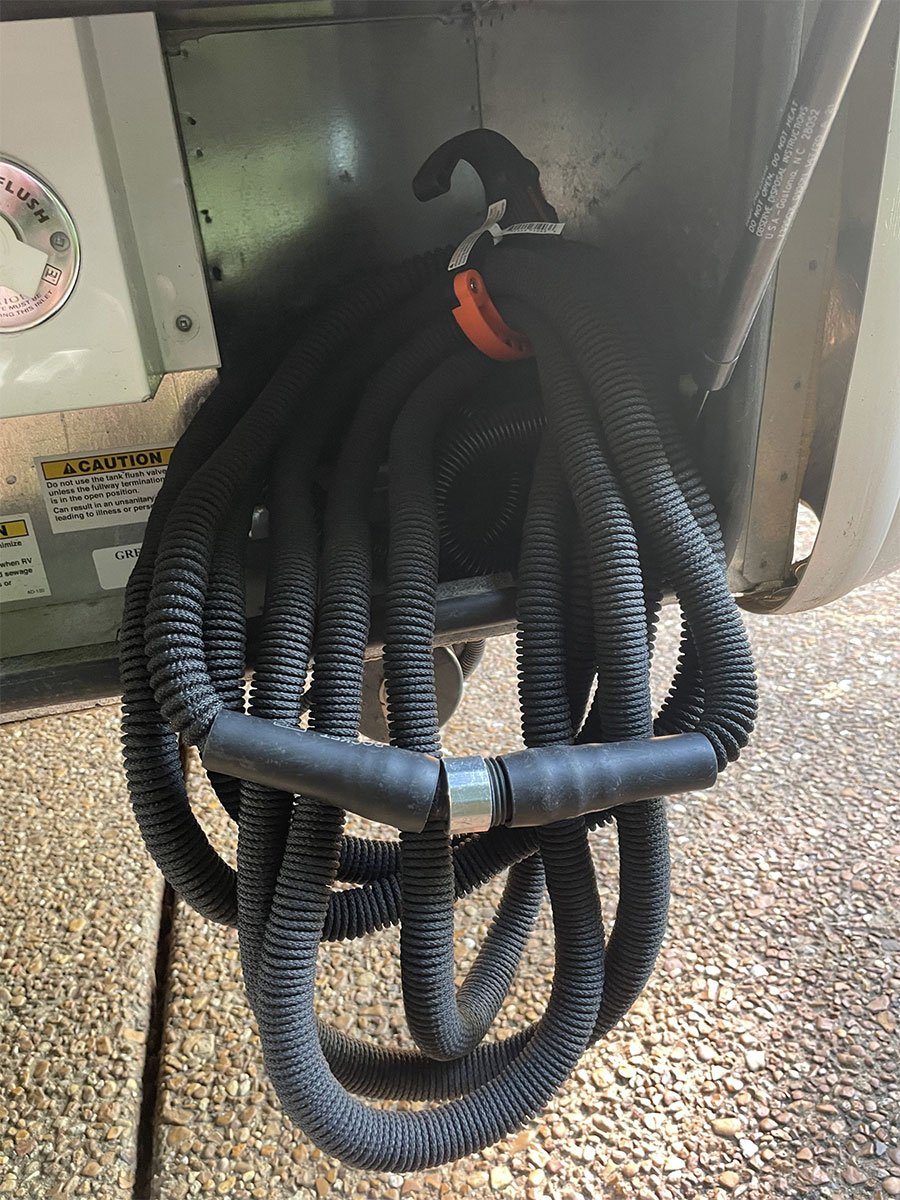
- A digital tire pressure gauge has proven to be so much more accurate and easier to use than my old-fashioned stick-type. This model has several extra features that recommend it—lights, seat belt cutter, and glass breaker. But the basic function of an easy-to-read tire pressure gauge is the best reason to have it.
- After three trips in which I had to look for help with inflating the inside tires on my rear dual wheels, I got the VIAIR Portable Air Compressor. It isn’t small or light, but it has the capacity needed to fill the tires on the Wonder. I think it will be of great use in checking my tire pressure cold before driving and making sure I can top off inflation when necessary. I’ve already used it several times on cars at home and hope it will be a good investment, especially at a sale price from Amazon.
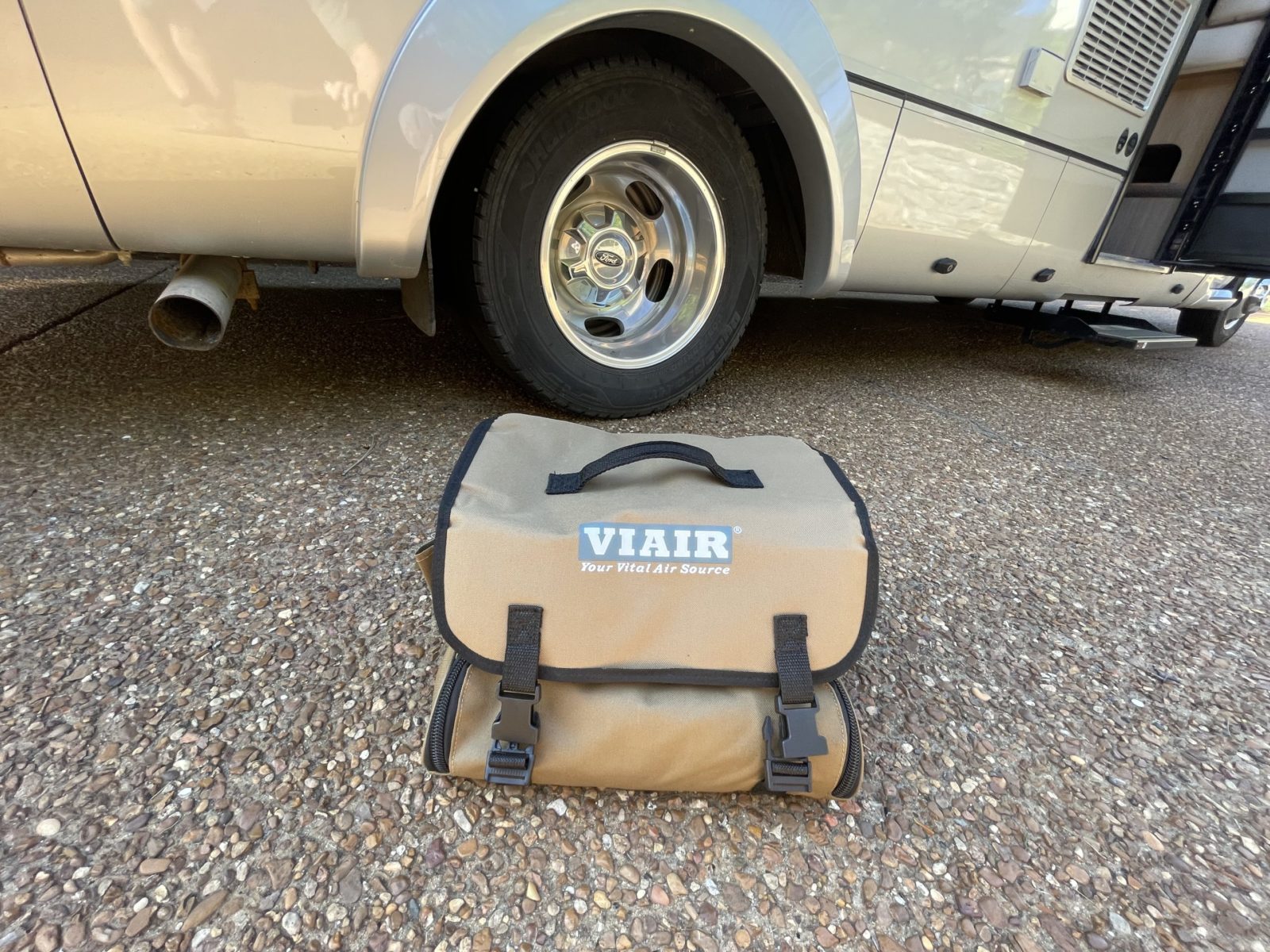

Inside
- We bought three “Waterhog” floormats from L. L. Bean. Two of them are typical welcome mat-sized, 23″ × 35″. We put one on the floor at the top of the steps, where it catches dirt from entering AND in the kitchen, and another in the rear lounge. The third is a longer, 2’6″ × 6′ runner, which fits extremely well in the hallway connecting the kitchen to the rear lounge. They all have a rubberized backing, so they don’t tend to slip, but we can slide them around for best placement. They can be easily vacuumed (which we do daily), removed and shaken, or hosed for deeper cleaning. They catch dirt, grass, and fur from the dogs, and they often use them for sleeping. Plus, they add a bit of insulation for our feet on chilly nights. They roll them compactly for storage, are very durable, and come in a variety of designs and colors to fit your taste. We got one with mountains, another with two dogs, and a runner with trees.
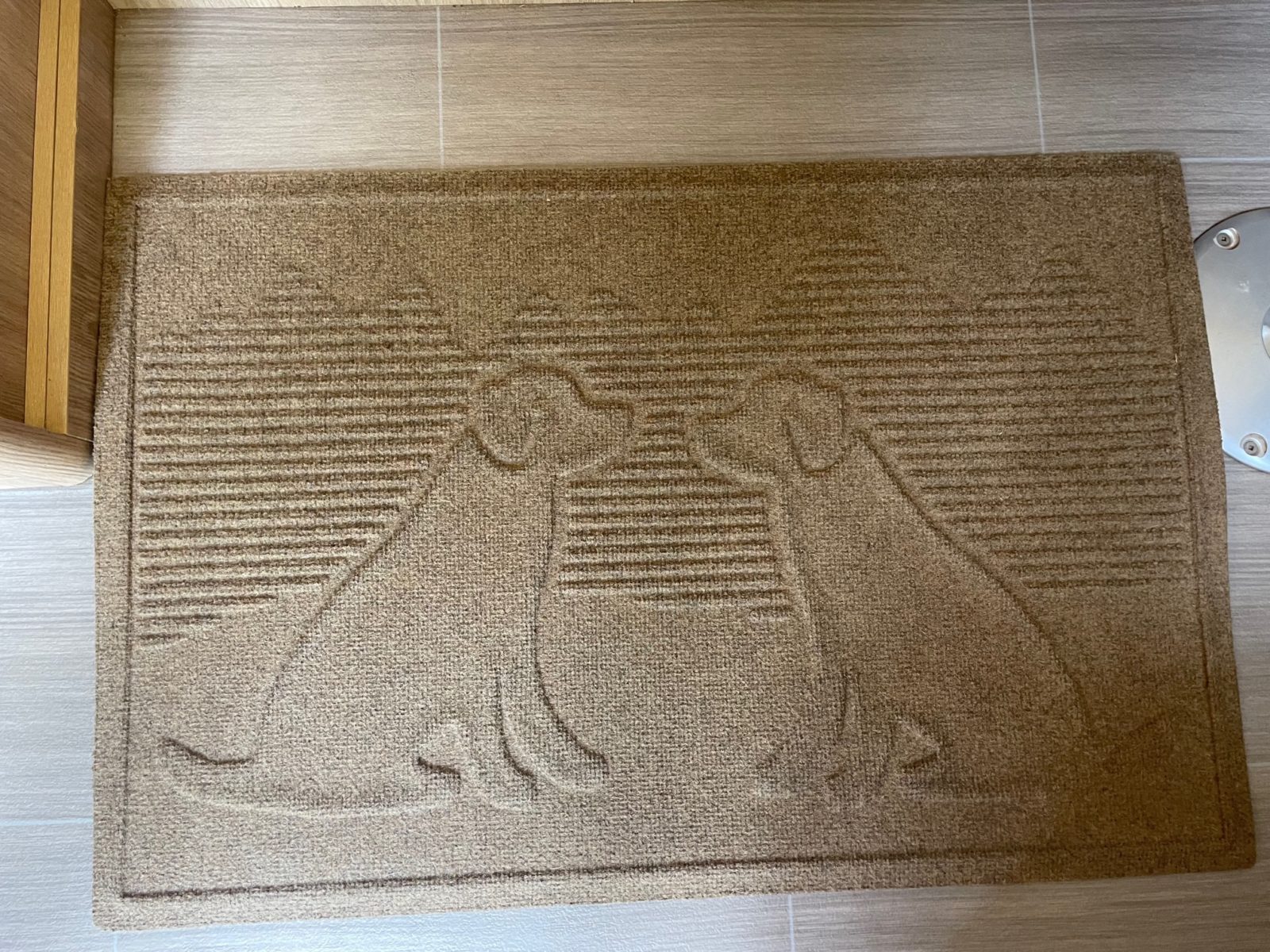
- We wanted a different silverware drawer organizer than the one that came with our Wonder. We looked online at the options and chose this one. Obviously, everyone has their own tastes and needs for space in the top drawer. This works well for us and gives us some room on the side and in the back for longer knives, spoons, can openers, corkscrews, and other gear.
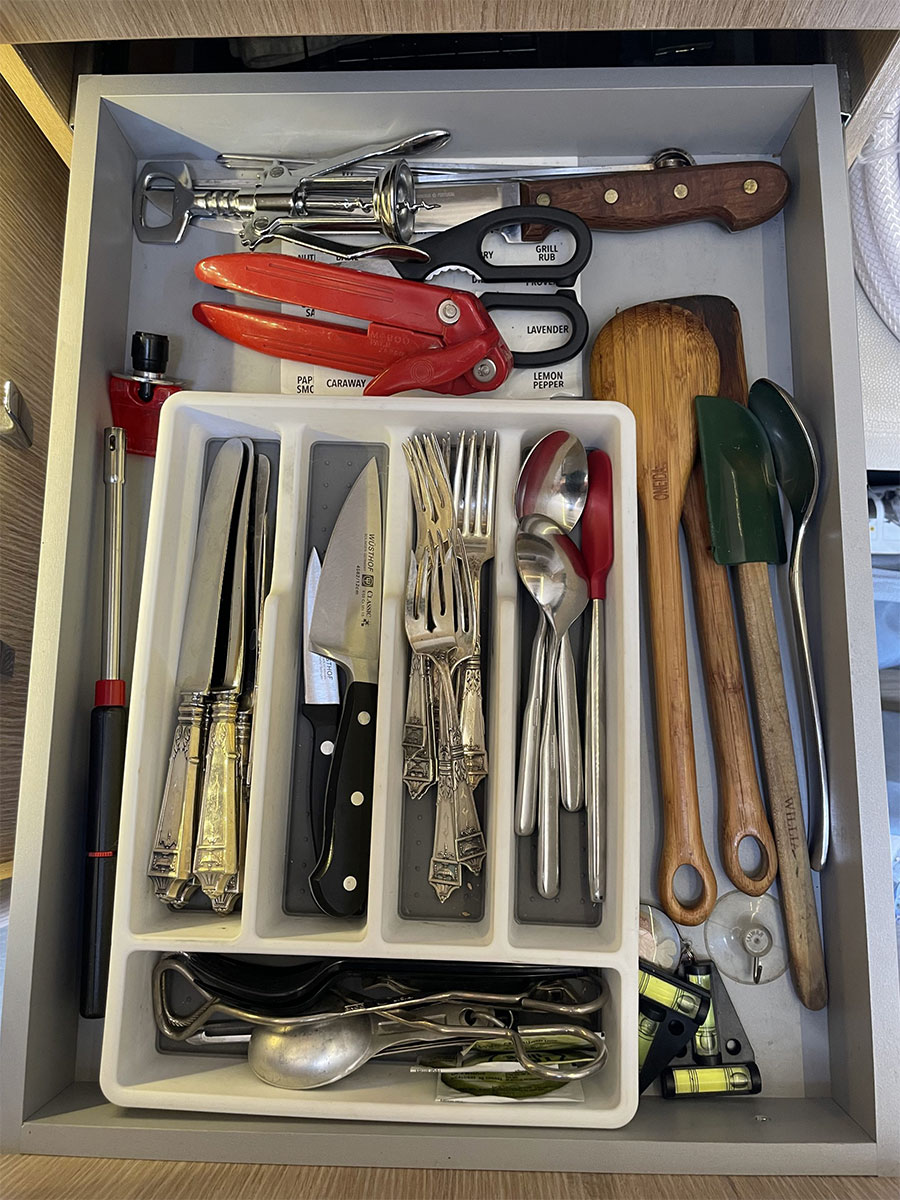
- Bissell portable, corded vacuum. We really tried to avoid buying stuff in general and particularly items that required more power and storage space. So we first traveled with a broom for sweeping the floors, plus a pet fur brush and shaking for the rugs. After two long trips and part of a third, I was fed up! The nearest Walmart came to the rescue, where we found our vacuum. Once again, there are lots of options on the market, but we wanted one that was corded and not battery powered, relatively compact, and would do well with all the dog fur. We now use it every day and store it in the shower. It is so much easier to clean the floor now! We also carry a small whisk broom for the entry steps and the front area floors.
- Air Purifier. We bought a small, plug-in ozone air purifier that we leave in the kitchen outlet near the TV. We turn it on for a while after we cook something with a strong smell or when the dogs are damp. It is adjustable, creates a faint smell of ozone, which is claimed to bind with the odor particles (it’s not a fragrance-based air freshener) and makes a slight pleasant hissing noise. The model we have apparently is no longer available, but other small air purifiers like this look similar.
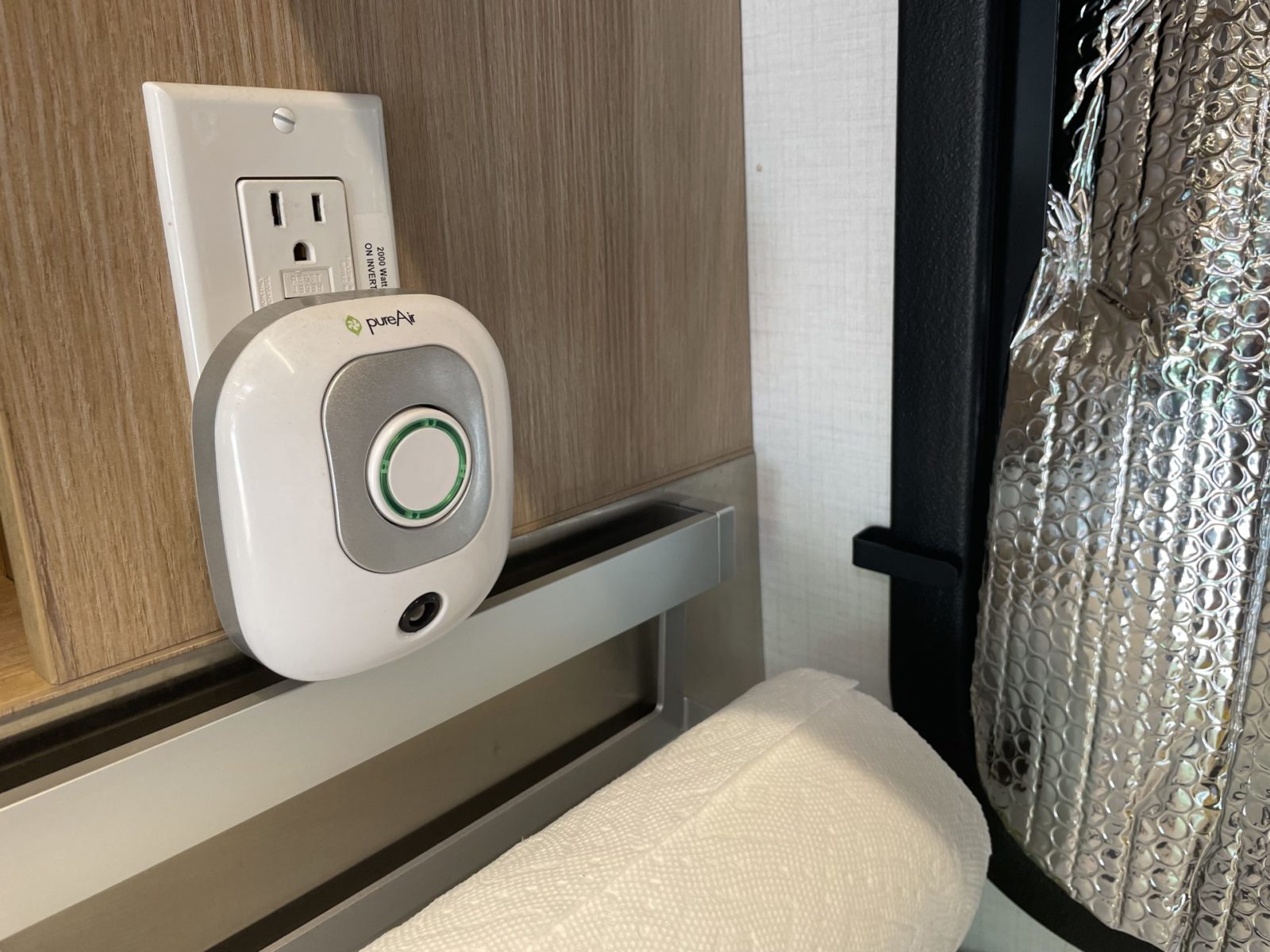
- Command hooks that closely match the factory-installed coat hooks just inside the door. We put them up on the panel above the light controls as a good place to hang keys and hats, and we use the other hooks for jackets that hang further down. There are many types available on Amazon for you to choose from.
- Headlamps have been very useful for nighttime set-ups or trips outside the vehicle with the dogs or to the bathroom. Ours are Black Diamond, five years old from REI on sale, but there are many options. Besides the variety of brightness settings, a nice feature is a red-light option, which doesn’t hamper night vision as much. They fit nicely in the little square space above the door, to the right of the inverter controller.
- We got a handheld squeegee from Bed, Bath, & Beyond. We use it to wipe down the walls and floor of the shower when condensation is a concern or for moving excess water into the drain and keeping areas from getting soap scum and water deposit buildup. We also use it at the front of the vehicle to wipe off the condensation that builds up on the inside of the windshield overnight. Otherwise, it takes the defroster a long time to clear the glass enough to drive. We also like to keep an absorbent rag close by in one of the many dash storage areas to wipe the squeegee dry. This isn’t a perfect or streak-free fix, but it gets us going faster.
- Enzyme-based RV digest-it liquid tank treatment. It’s simple to use—no mixing of powders, and we just pour a measure down the toilet to add it to the black tank after every dump. Everyone agrees that holding tanks work (and smell) best with a treatment to help prevent odors and break down waste. We’ve tried to avoid strong chemicals, and a bottle of RV digest-it liquid usually lasts us a full trip and longer. Others have recommended Happy Campers or Thank Tank. Again, there are numerous brands to try.
- It’s been very helpful to have Reflectix windshield, and side window fitted covers for the Ford Transit 350 chassis. We got these covers after trying the privacy curtain to offer a little extra insulation and easier installation. More, they give us and our dogs access to a bit more of the front space than the curtain, and they keep the dogs from peeking underneath the curtain and seeing things to bark at in the early morning! These shades roll up for storage and press-fit pretty well into the windows—no snaps or magnets to install. We also bought a 10′ × 2′ roll of Reflectix Foil Insulation and cut pieces to fit the cabin windows and fan openings for offseason storage. Our primary purpose was to reduce sun wear through the windows, and it worked. If we were winter camping, these pieces might be valuable enough to warrant the space they would take for their improved insulation.
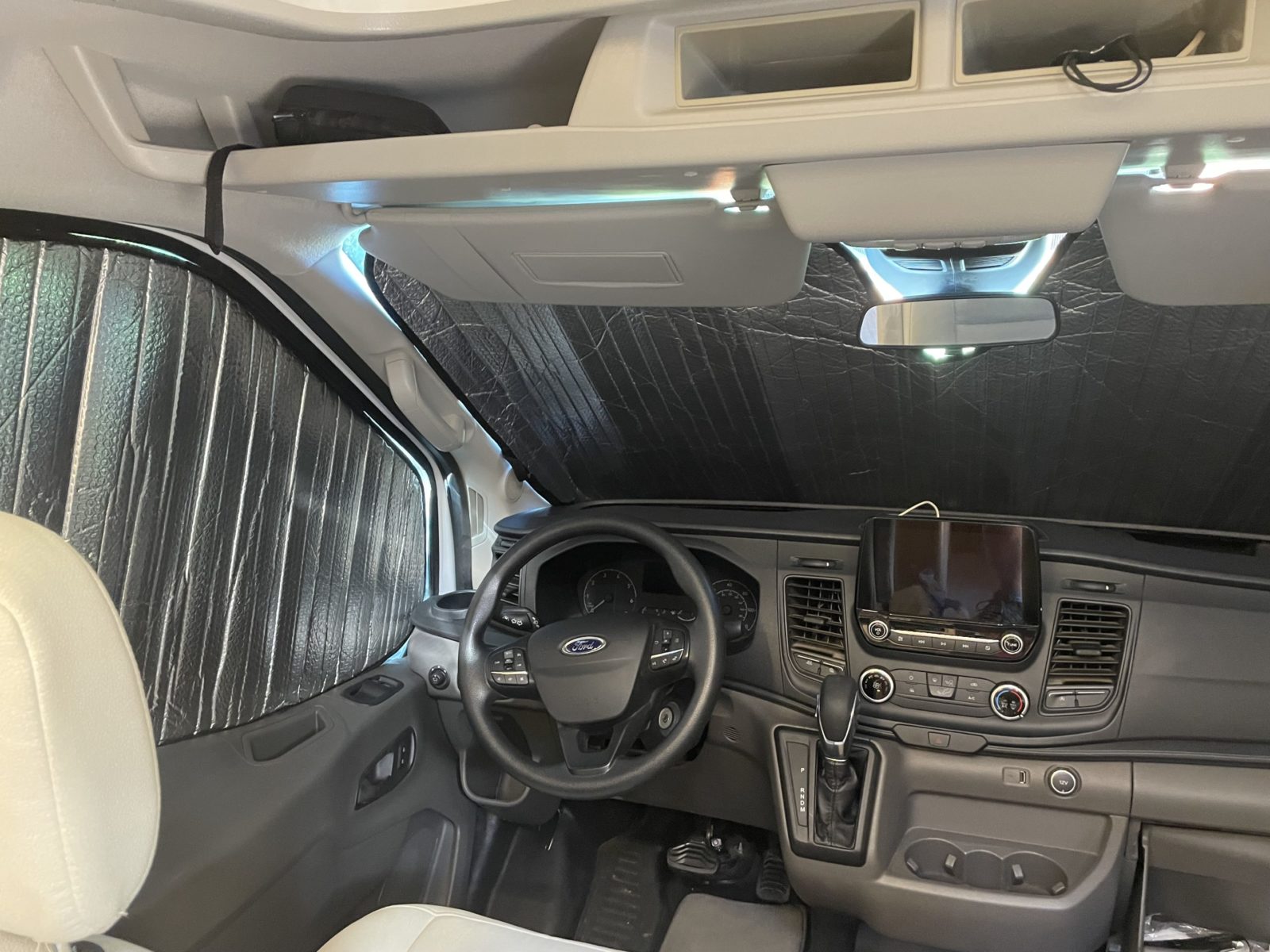
- I visited the local auto parts store to pick up an assortment of fuses that might be needed—so far, they haven’t been. Look at the fusebox chart in the owners’ manual to see what you might need to replace, then get some extras.
- If you are dry camping, chances are you will want some extra water even if you conserve. Instead of buying bottles, we got a set of four 2.5-gallon collapsible water bottles. With these, you aren’t discarding plastic bottles; they are lighter to carry than the larger versions and collapse for storage under the rear bench when you don’t need them. When traveling with them filled, we put them in the shower in case there’s a leak.

- Finding small cookware with multiple uses is challenging in limited kitchen space. We use a wok a lot, so the Lodge 9″ Cast Iron Wok was a good find. It fits in the bottom drawer quite nicely and is the right size for the cooktop and for two people. It stir-fries greens or full meals and spills less than a frypan.
- For a lark, I found Silipint 16 oz. tumblers with lids in riotous colors, as well as some more sedate wine tumblers/juice cups. We quickly came to love them for their many advantages. They hold hot or cold liquids, are flexible, don’t break, don’t rattle, are grippy, the lids don’t spill, and you can squeeze them into the dish cupboard in numerous in-between places; plus, the color options are a trip!
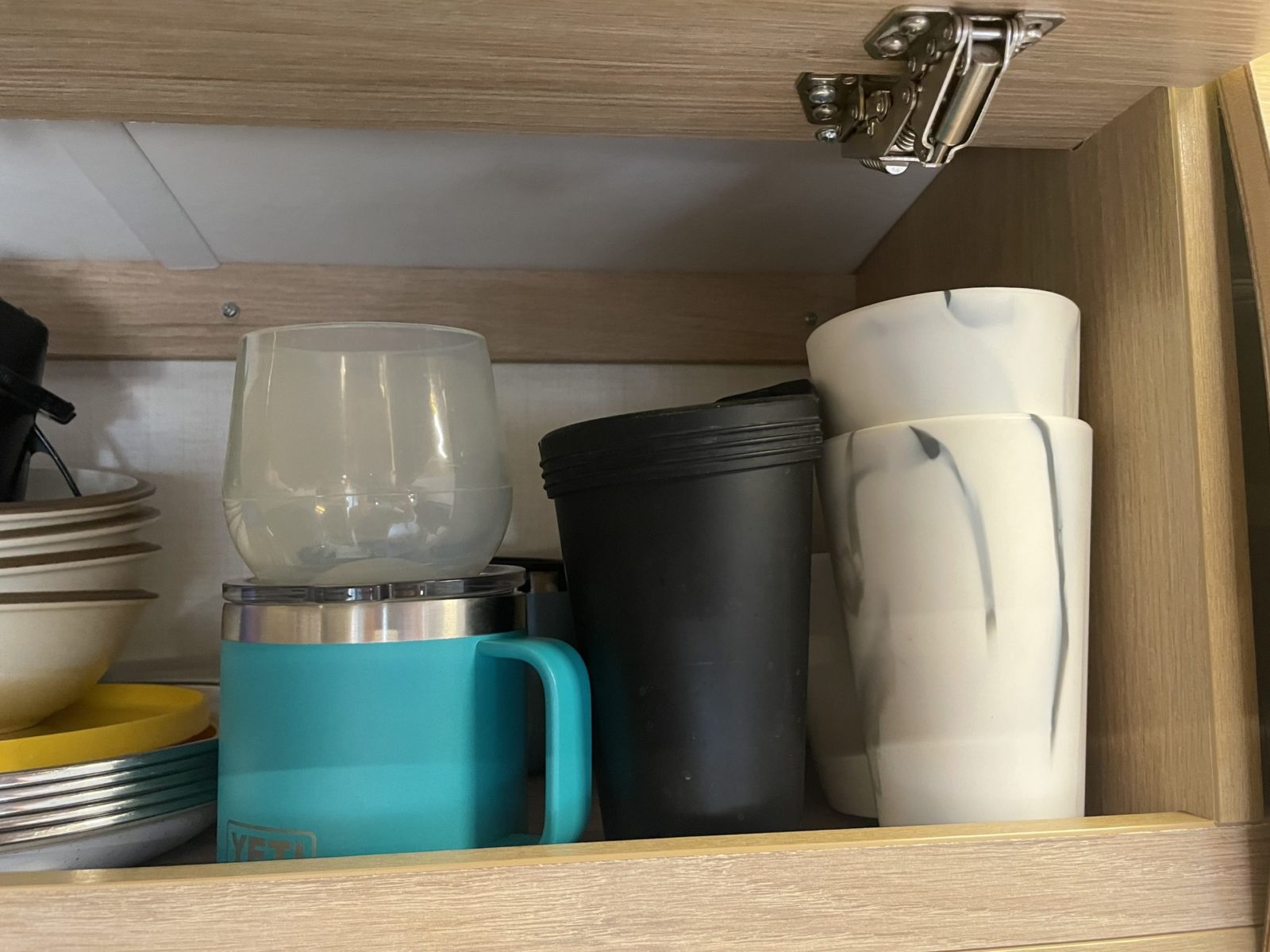
The rest of our cookware is mostly old pots, pans, and utensils that have made their way over from our kitchen over the years We use an old, round deep-dish pizza pan as a roasting pan that fits into the convection oven. But we have fun by taking along real silverware and cloth napkins handed down from our grandparents, and we’ve picked up some lovely placemats and candles along the way to dress up the table. The freezer holds a remarkable amount of meals frozen in advance, so we eat pretty well! It’s fun to have lovely, elegant meals in the middle of some wild and abandoned setting.

Some Other Items That We Love
- Rechargeable, battery-powered cordless clip-on fans that can be moved from place to place. We use them mostly on the side and front bulkheads for extra air movement when it was hot—for us in the chairs at the front and for the dogs sleeping at night. We can move them to the back at night, but the fantastic fan over the bed has usually sufficed.
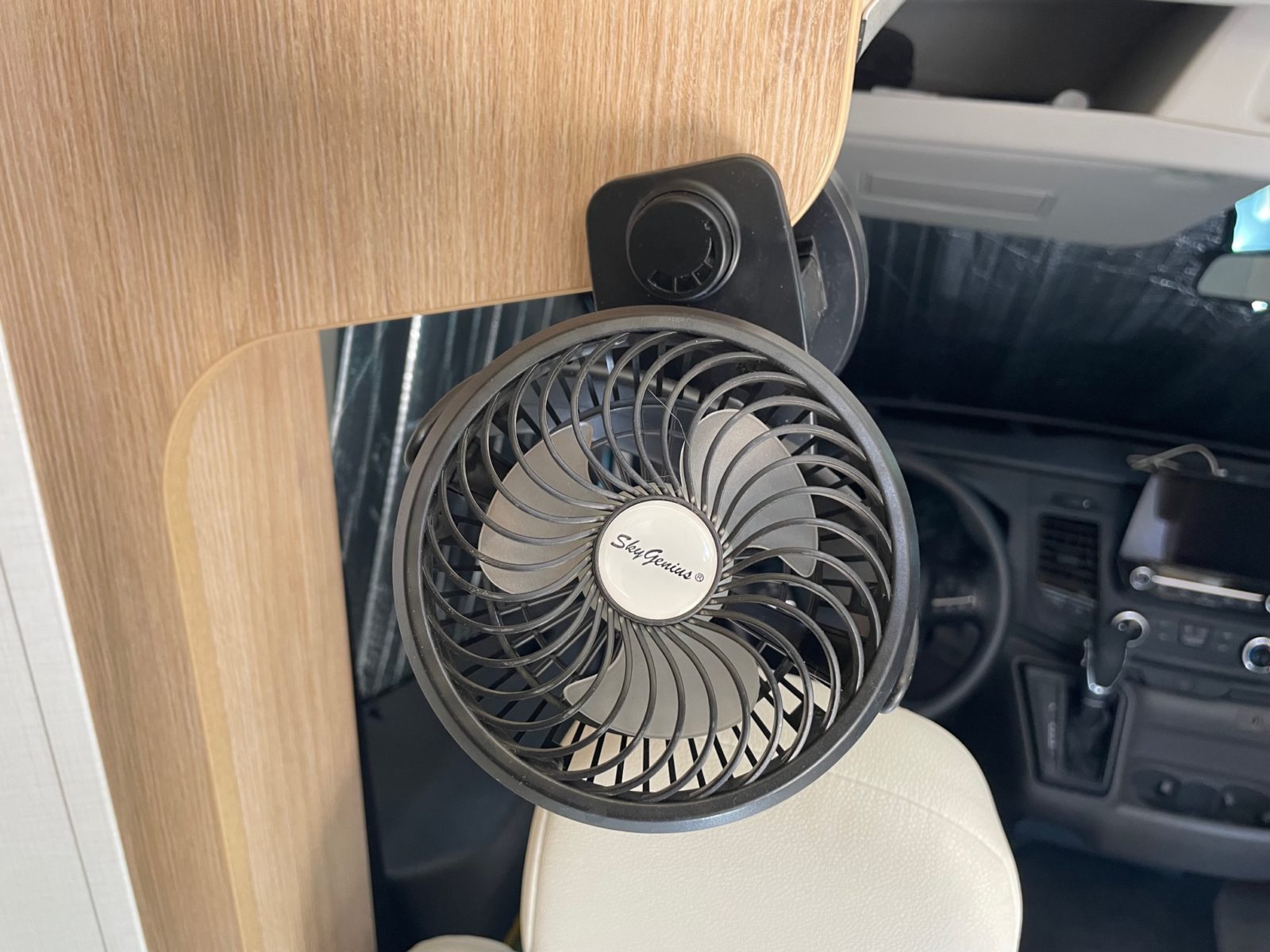
- Battery-powered refrigerator fan for better cold air circulation in the interior. I’m not sure this made a huge difference, but it is clear that there is a temperature difference between the top and bottom shelves of the rig, so in theory, this fan should help even that difference out.
- Museum Wax to hold our things in place—like the toothbrush holder on one of the little corner shelf spaces in the bathroom. A few small balls of this pliable putty-like wax under the holder have kept it in place solidly. They are removable and leave no permanent residue.
- Anti-static dryer sheets have been helpful since all the various screens and surfaces attract and hold dust due to static charges. I’ve used them to lightly wipe the plastic front surface of the refrigerator, the dashboard, the navigation screen, and the TVs. Microfiber rags have been good for cleaning those surfaces as well.

These are my uncompensated and experience-based suggestions. There’s so much to learn about what you really need and what won’t get used much in the limited space you have in your LTV. It’s easy to go overboard with all the gadgets, and there’s so much available now on the internet, some just the result of Amazon searches. Plus, we all have our own unique preferences and needs.
I hope this is a helpful list of suggestions we’ve tried and found useful in our Wonder. I know there are many others, and I look forward to hearing about them. Happy travels!


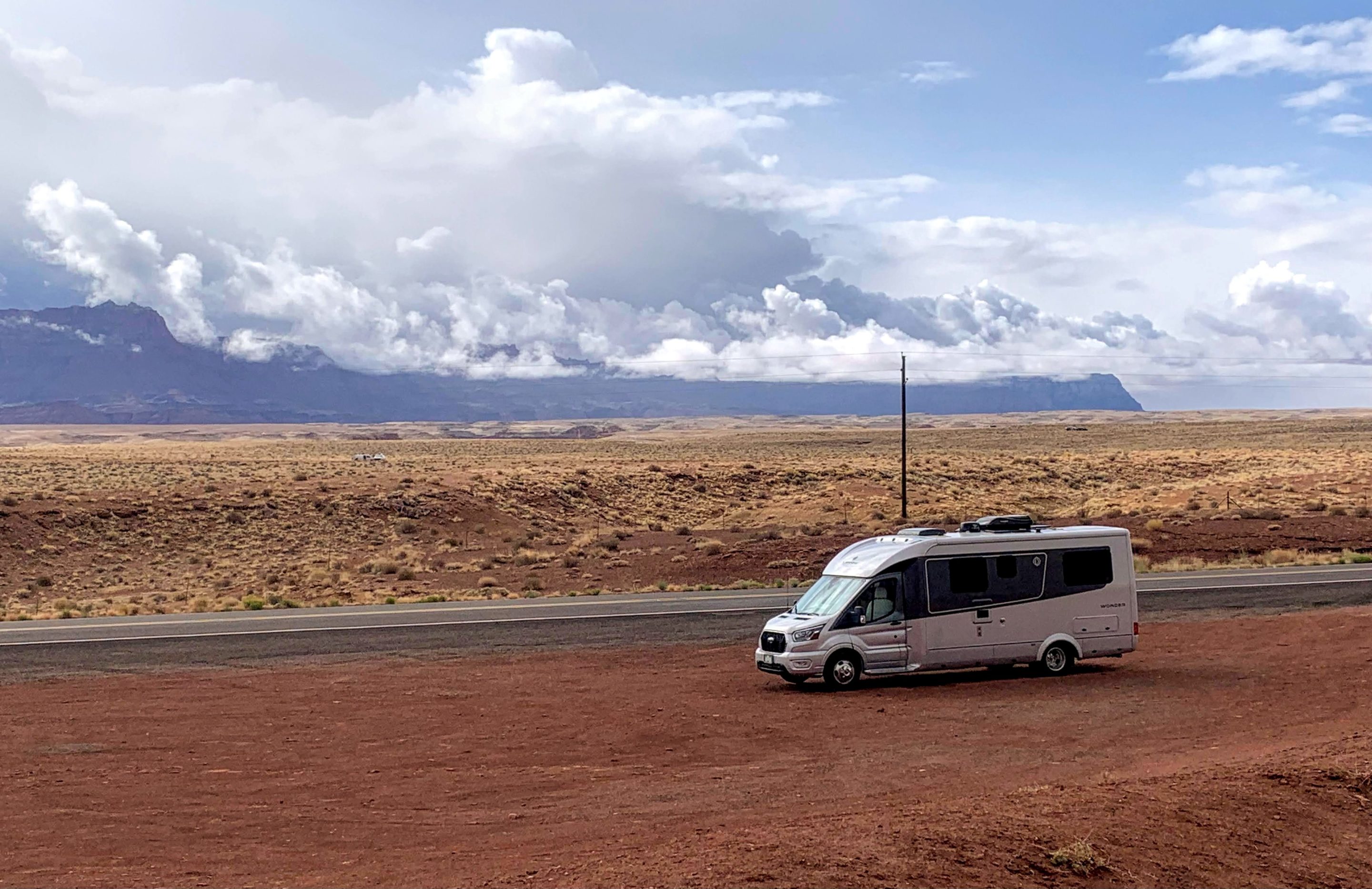
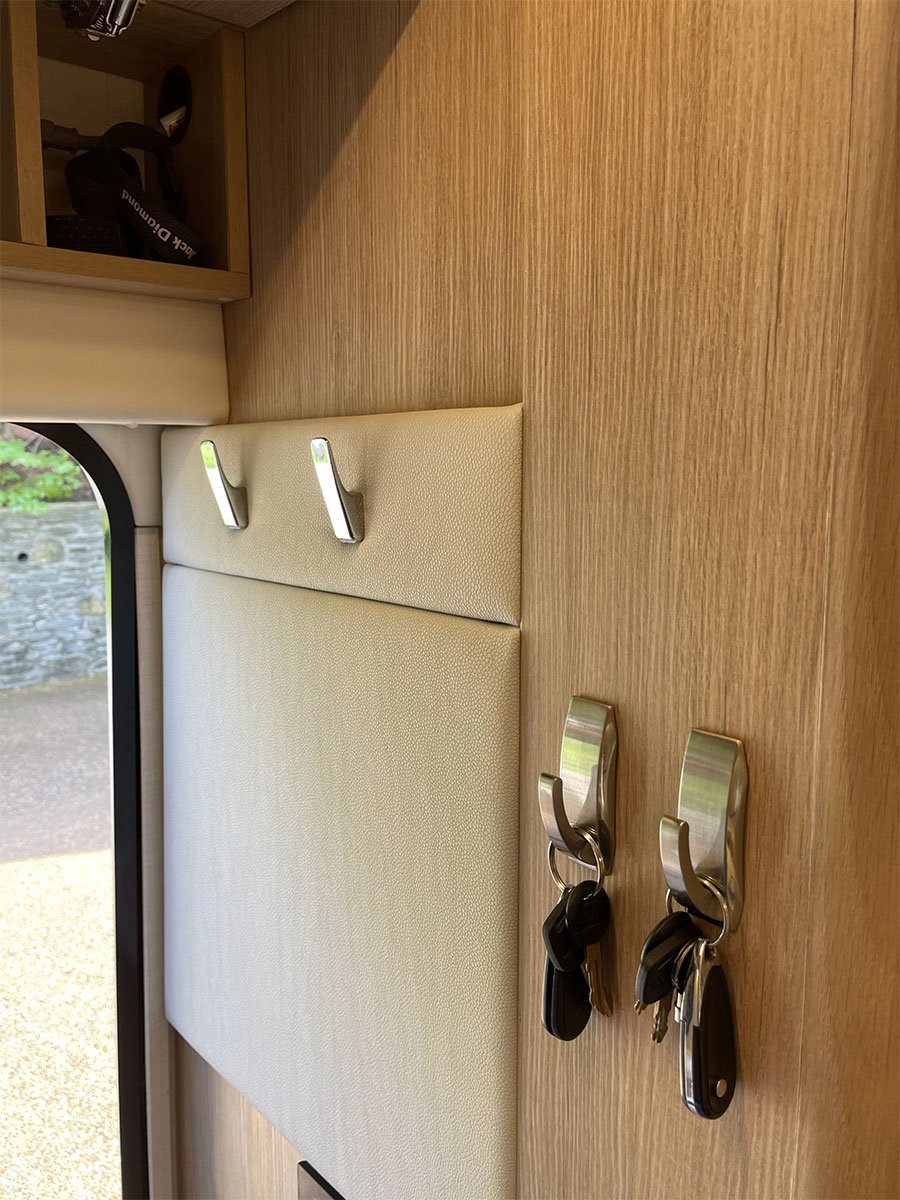
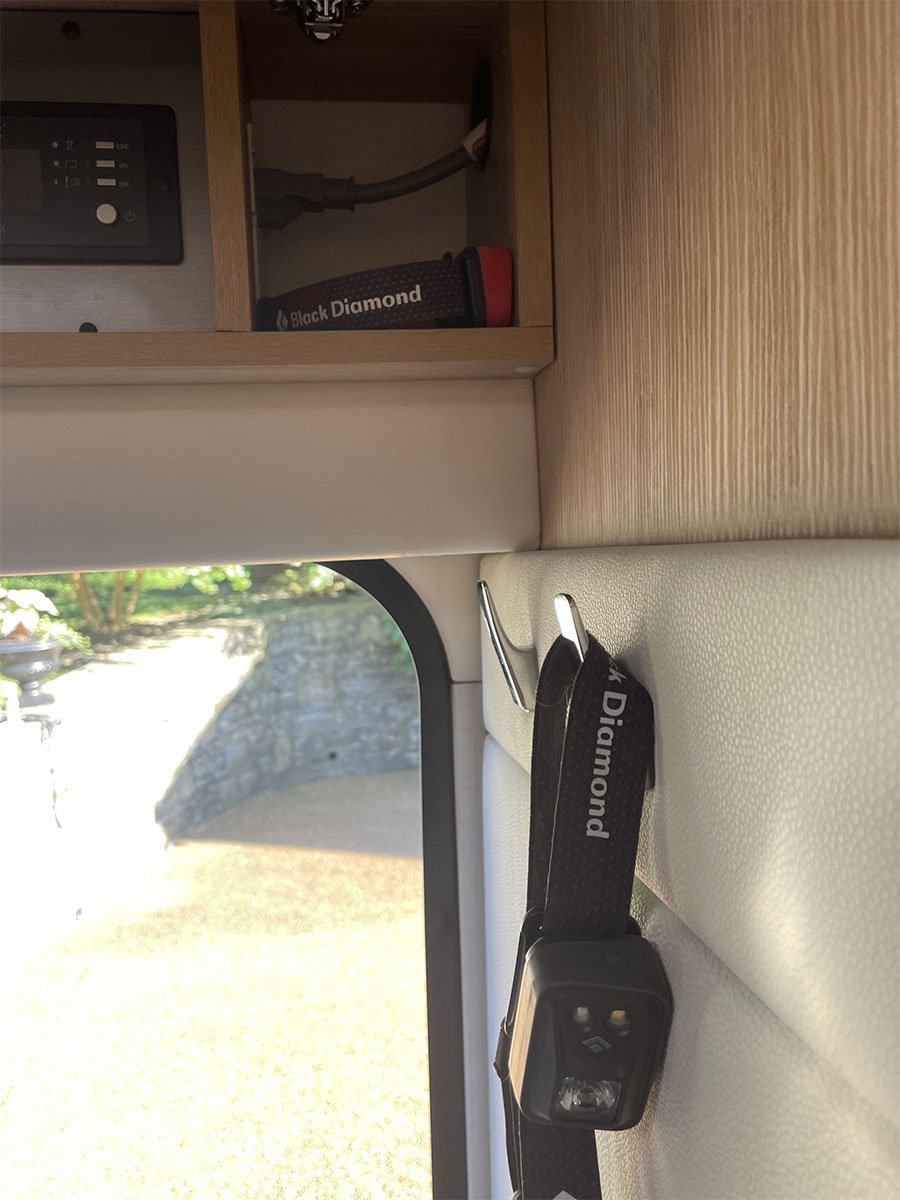

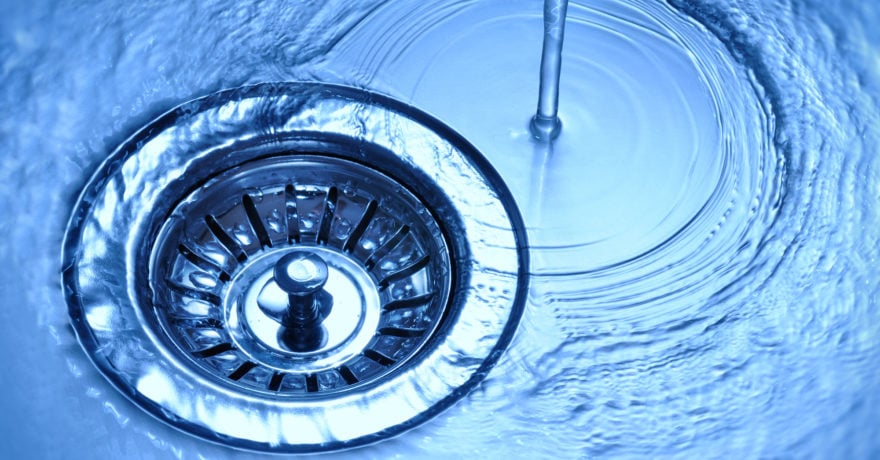

Comments